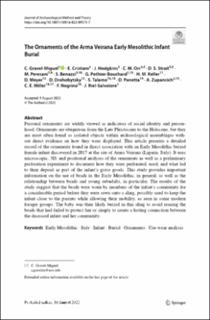| dc.contributor.author | Gravel-Miguel, C. | |
| dc.contributor.author | Cristiani, E. | |
| dc.contributor.author | Hodgkins, J. | |
| dc.contributor.author | Orr, C.M. | |
| dc.contributor.author | Strait, D.S. | |
| dc.contributor.author | Peresani, M. | |
| dc.contributor.author | Benazzi, S. | |
| dc.contributor.author | Pothier-Bouchard, G. | |
| dc.contributor.author | Keller, H.M. | |
| dc.contributor.author | Meyer, D. | |
| dc.contributor.author | Drohobytsky, D. | |
| dc.contributor.author | Talamo, S. | |
| dc.contributor.author | Panetta, D. | |
| dc.contributor.author | Zupancich, A. | |
| dc.contributor.author | Miller, Christopher | |
| dc.contributor.author | Negrino, F. | |
| dc.contributor.author | Riel-Salvatore, J. | |
| dc.date.accessioned | 2022-12-08T11:56:50Z | |
| dc.date.available | 2022-12-08T11:56:50Z | |
| dc.date.created | 2022-11-10T12:55:28Z | |
| dc.date.issued | 2022 | |
| dc.identifier.issn | 1072-5369 | |
| dc.identifier.uri | https://hdl.handle.net/11250/3036762 | |
| dc.description.abstract | Personal ornaments are widely viewed as indicators of social identity and personhood. Ornaments are ubiquitous from the Late Pleistocene to the Holocene, but they are most often found as isolated objects within archaeological assemblages without direct evidence on how they were displayed. This article presents a detailed record of the ornaments found in direct association with an Early Mesolithic buried female infant discovered in 2017 at the site of Arma Veirana (Liguria, Italy). It uses microscopic, 3D, and positional analyses of the ornaments as well as a preliminary perforation experiment to document how they were perforated, used, and what led to their deposit as part of the infant’s grave goods. This study provides important information on the use of beads in the Early Mesolithic, in general, as well as the relationship between beads and young subadults, in particular. The results of the study suggest that the beads were worn by members of the infant’s community for a considerable period before they were sewn onto a sling, possibly used to keep the infant close to the parents while allowing their mobility, as seen in some modern forager groups. The baby was then likely buried in this sling to avoid reusing the beads that had failed to protect her or simply to create a lasting connection between the deceased infant and her community. | en_US |
| dc.language.iso | eng | en_US |
| dc.publisher | Springer | en_US |
| dc.rights | Navngivelse 4.0 Internasjonal | * |
| dc.rights.uri | http://creativecommons.org/licenses/by/4.0/deed.no | * |
| dc.title | The Ornaments of the Arma Veirana Early Mesolithic Infant Burial | en_US |
| dc.type | Journal article | en_US |
| dc.type | Peer reviewed | en_US |
| dc.description.version | publishedVersion | en_US |
| dc.rights.holder | Copyright 2022 the authors | en_US |
| cristin.ispublished | true | |
| cristin.fulltext | original | |
| cristin.qualitycode | 2 | |
| dc.identifier.doi | 10.1007/s10816-022-09573-7 | |
| dc.identifier.cristin | 2071825 | |
| dc.source.journal | Journal of Archaeological Method and Theory | en_US |
| dc.identifier.citation | Journal of Archaeological Method and Theory. 2022. | en_US |

